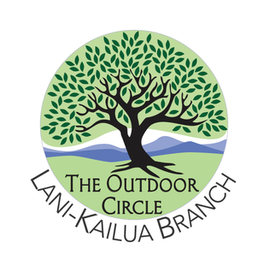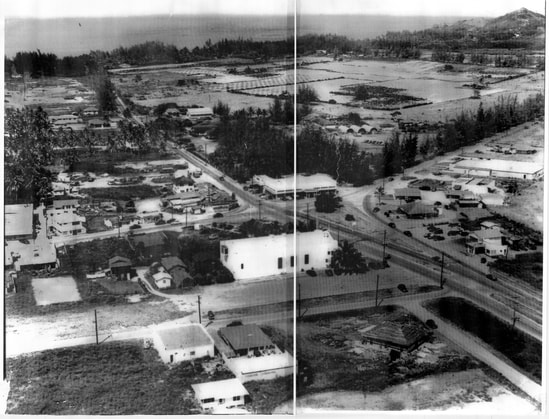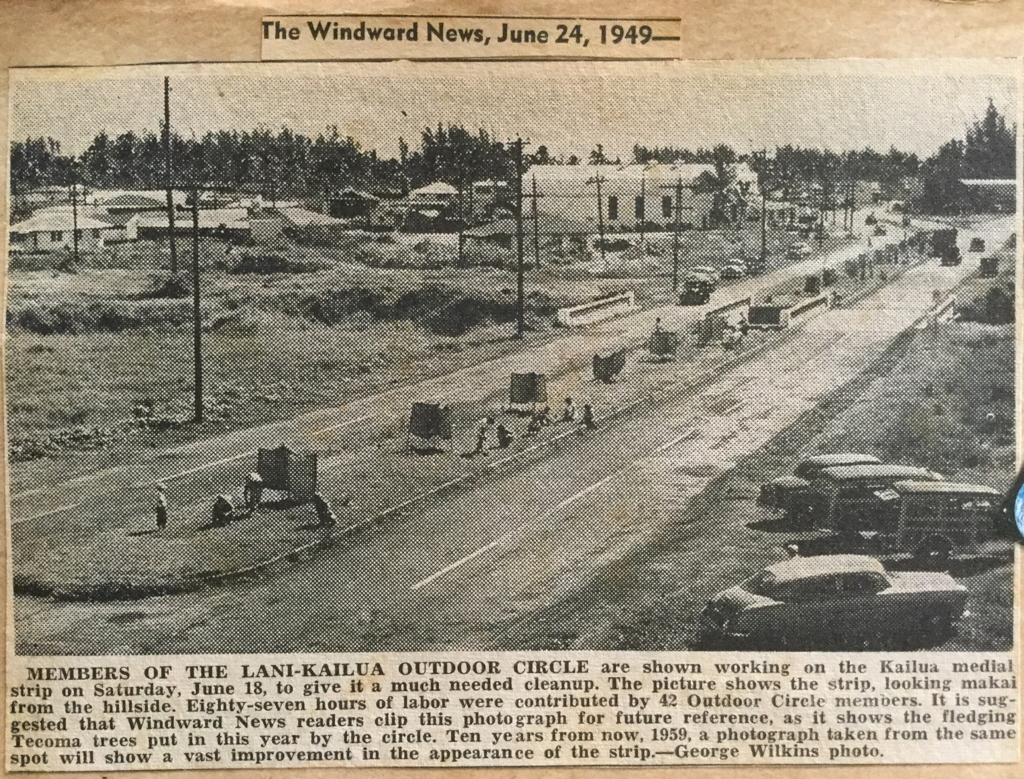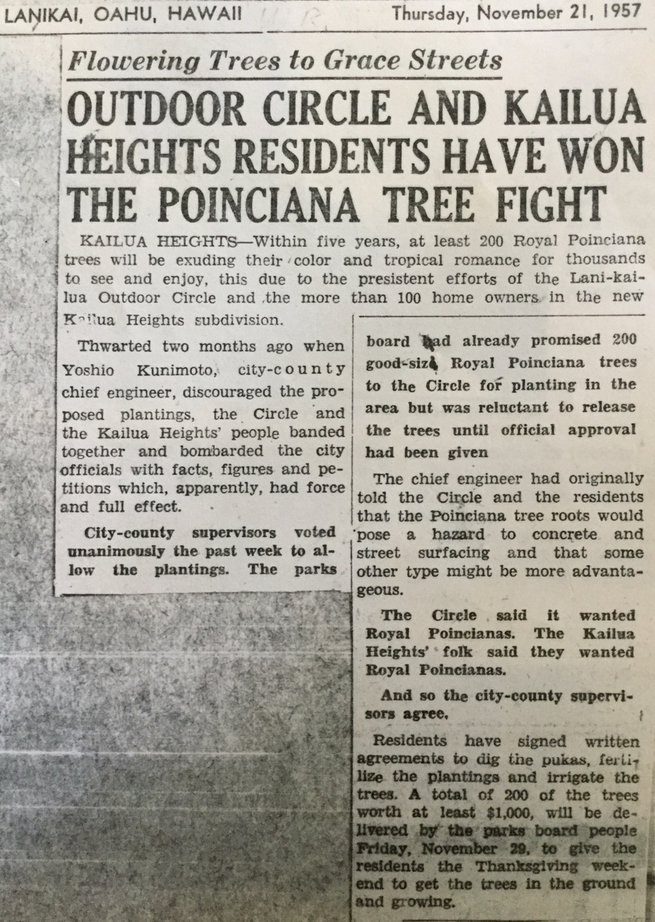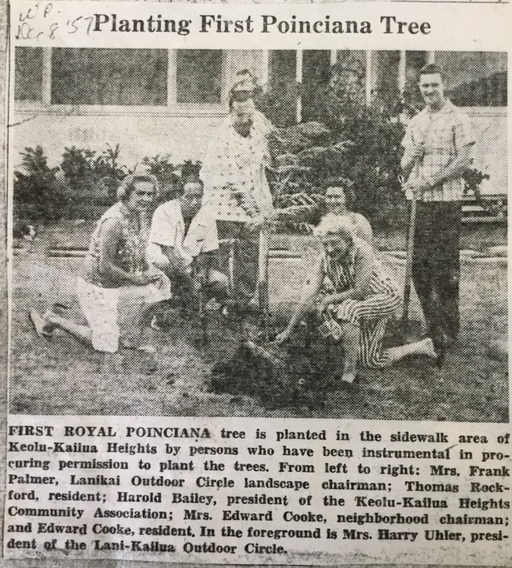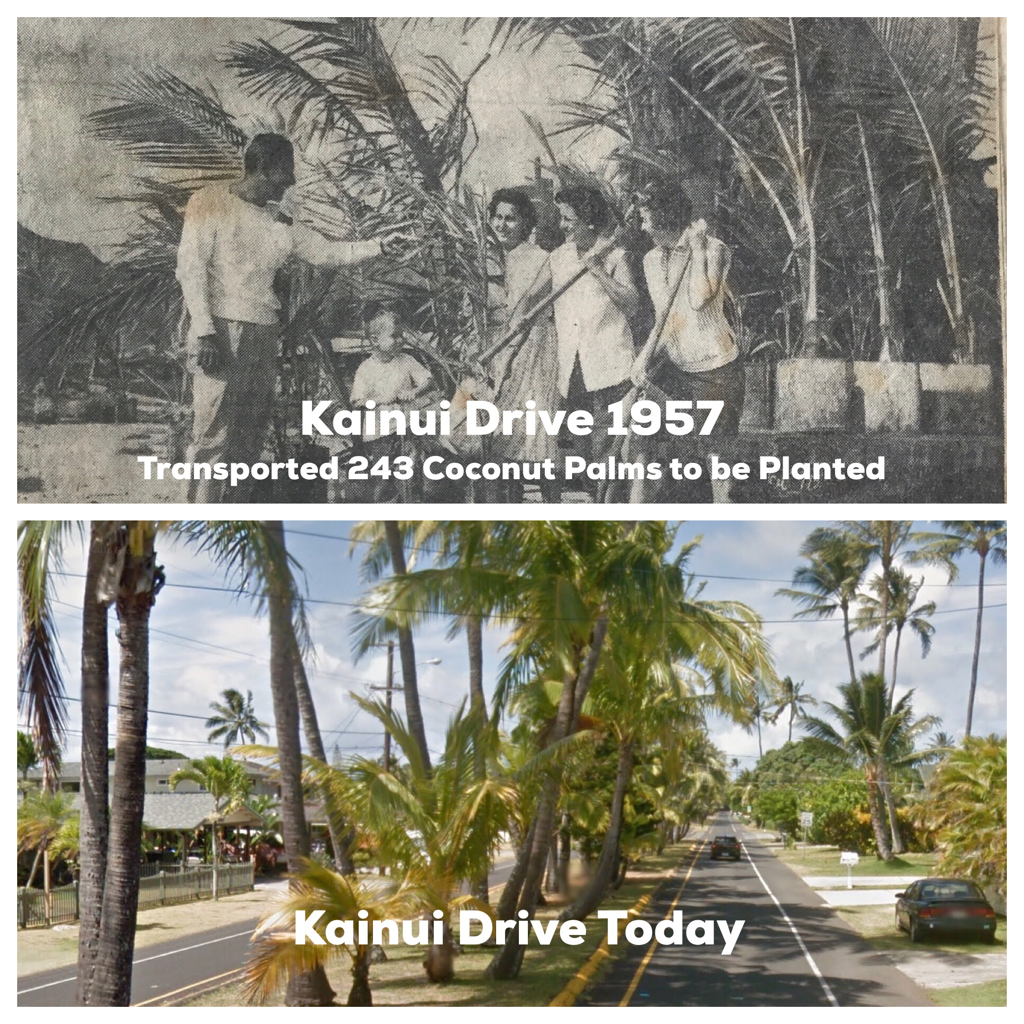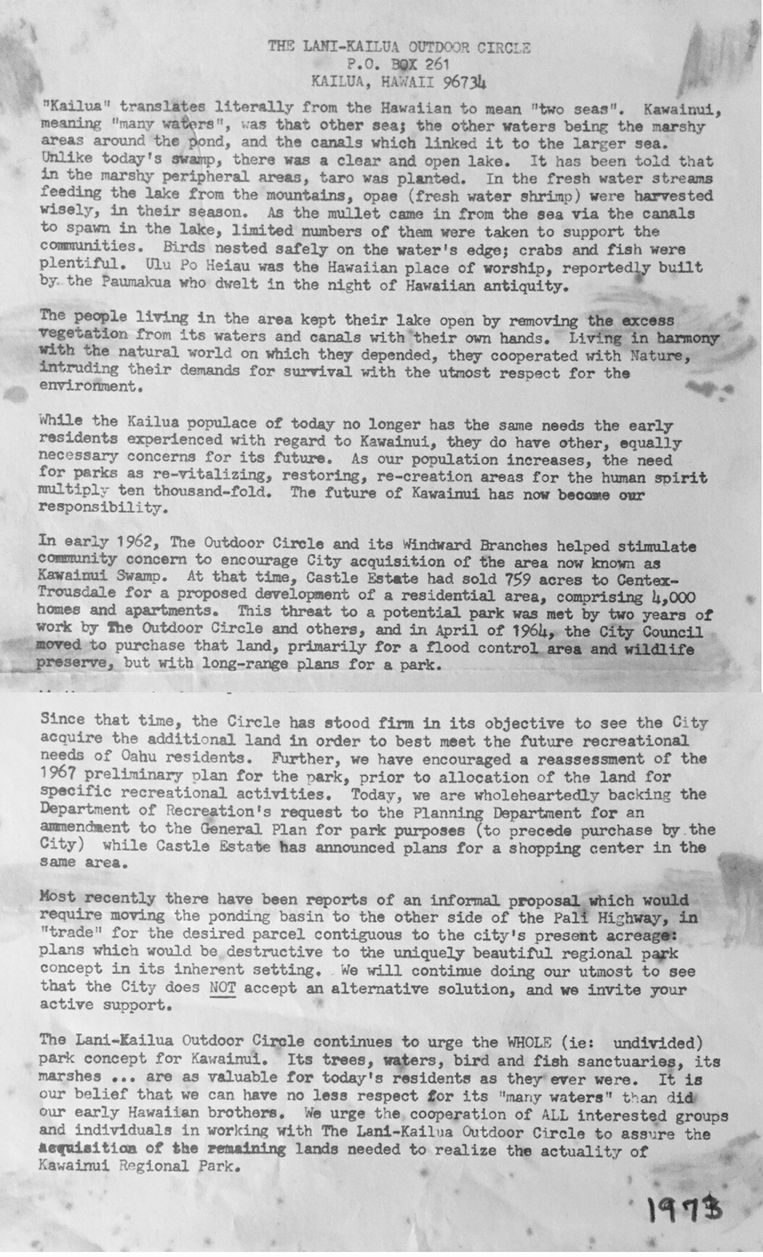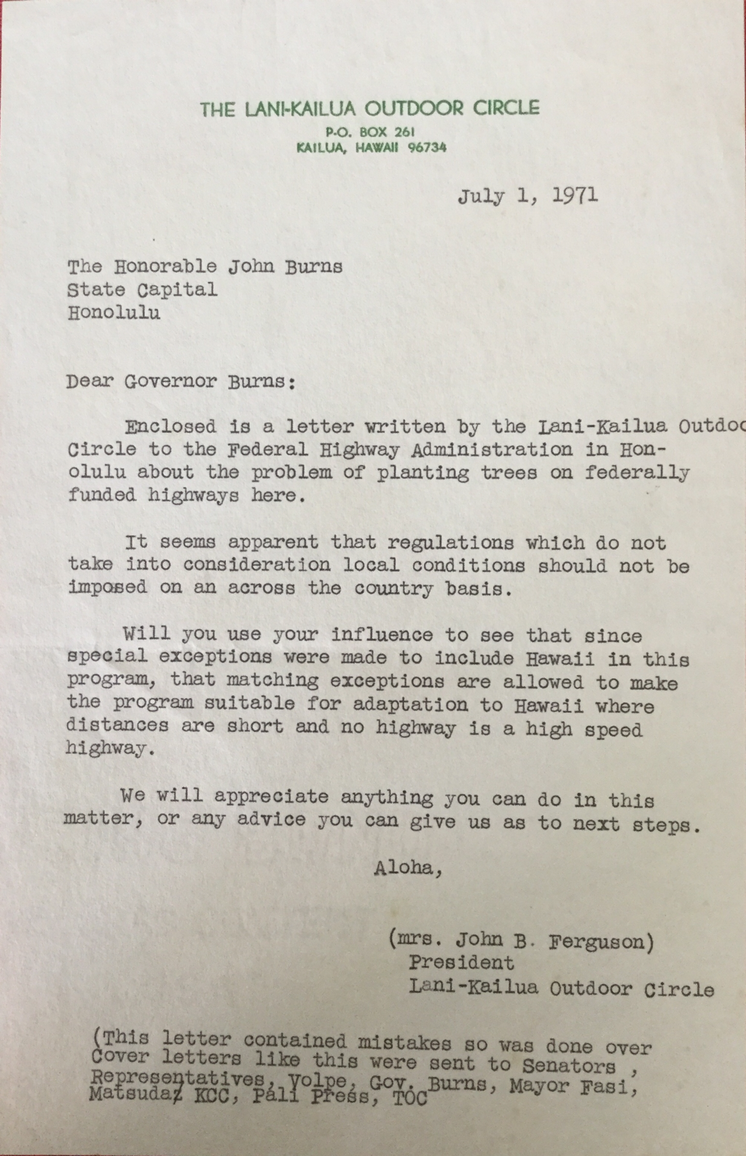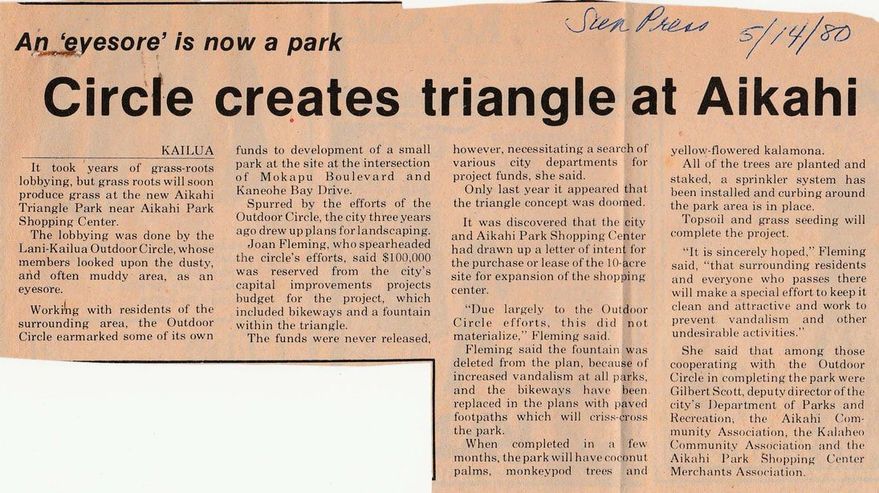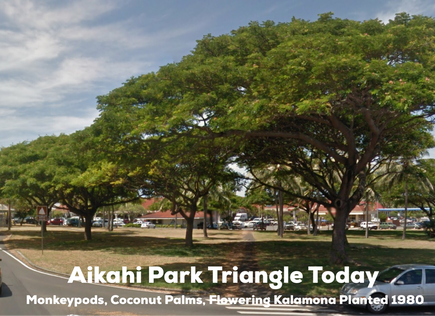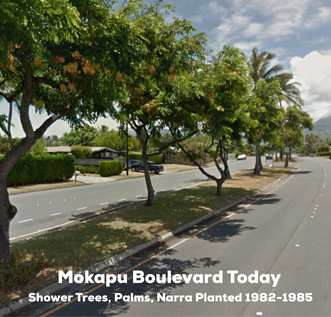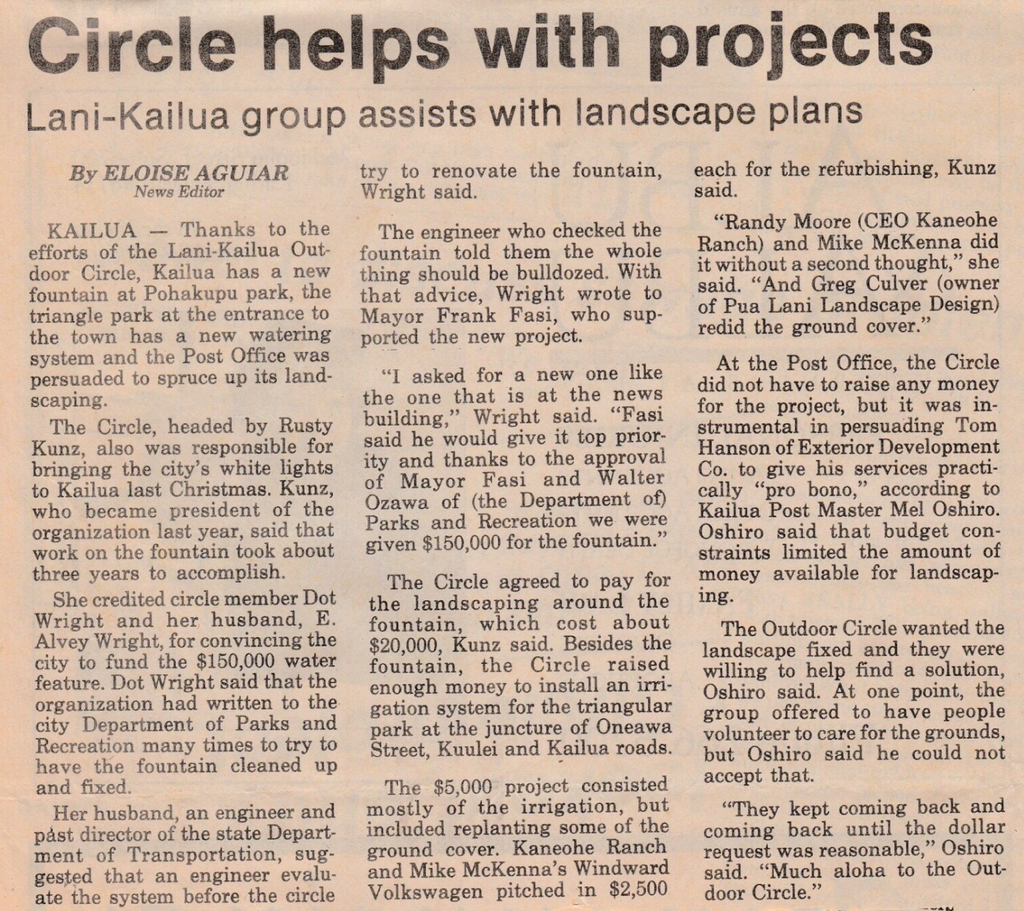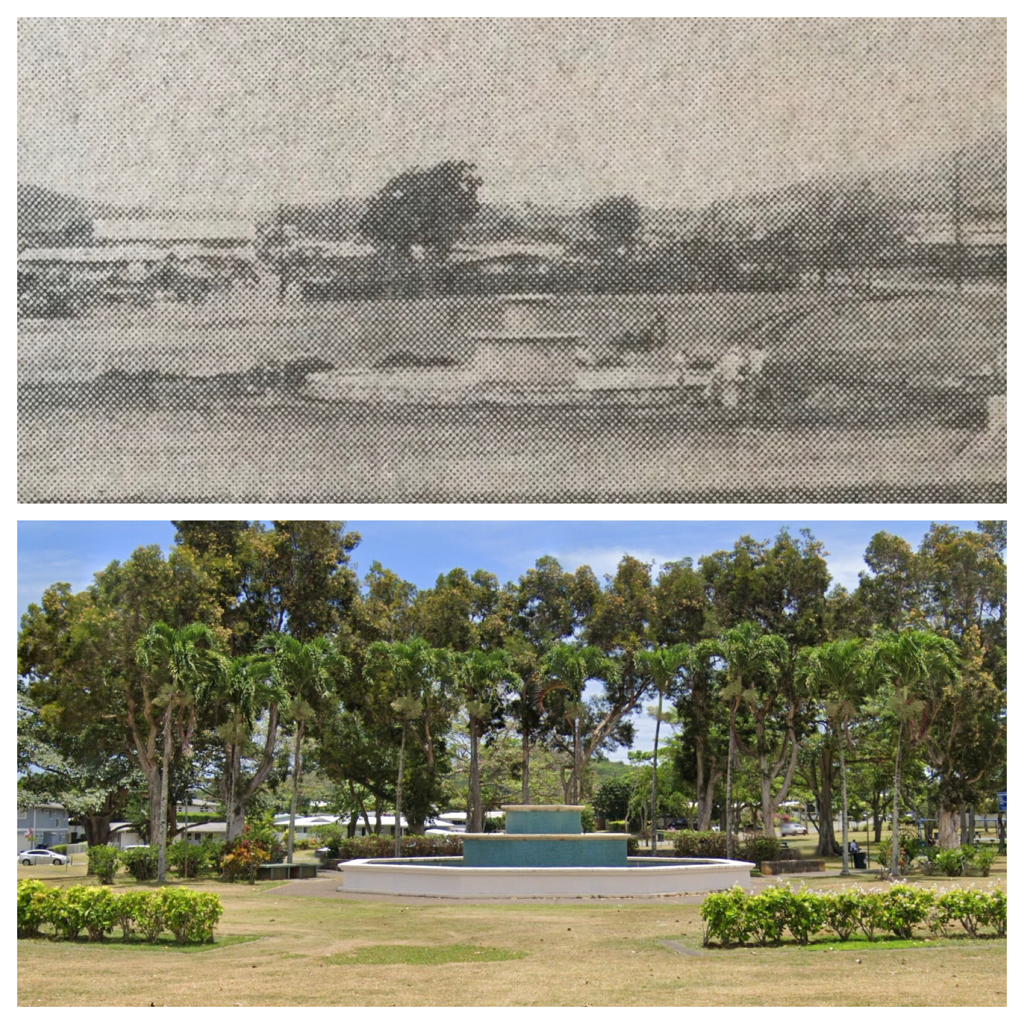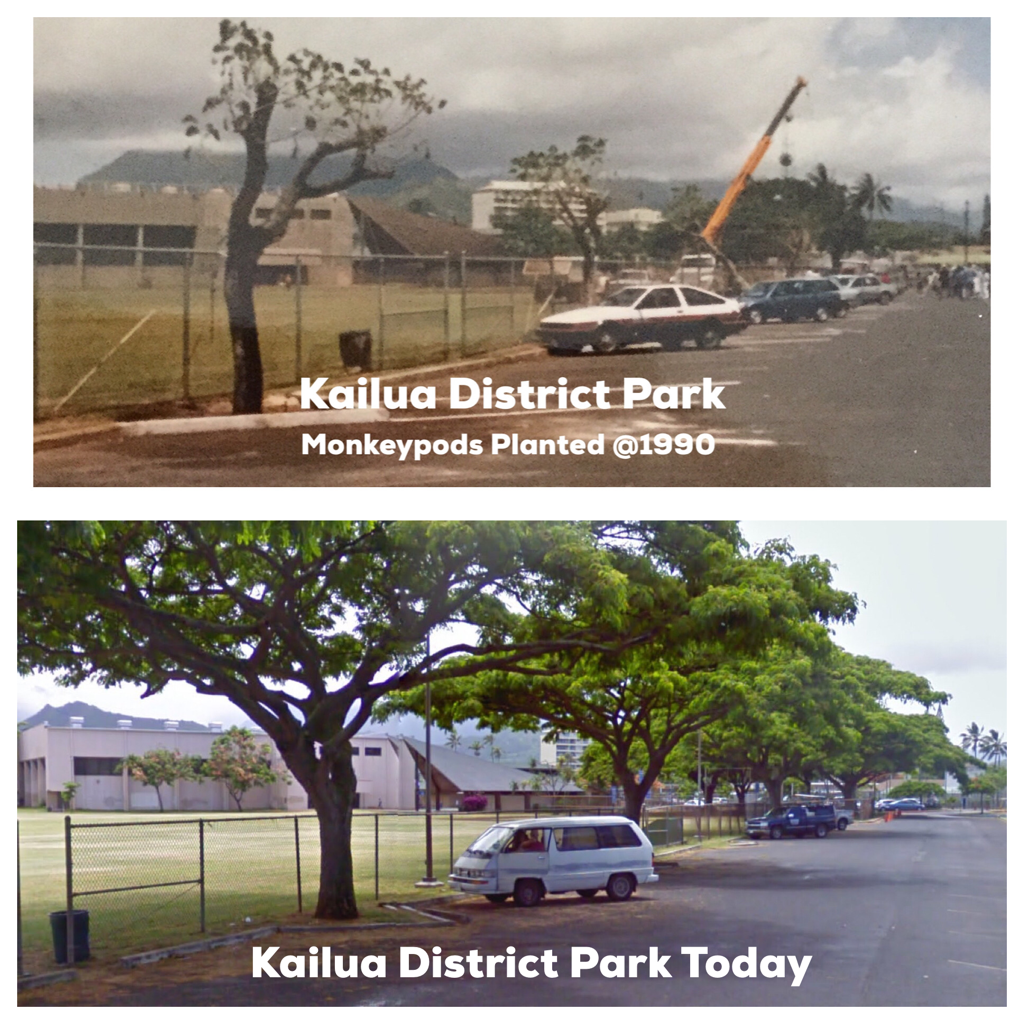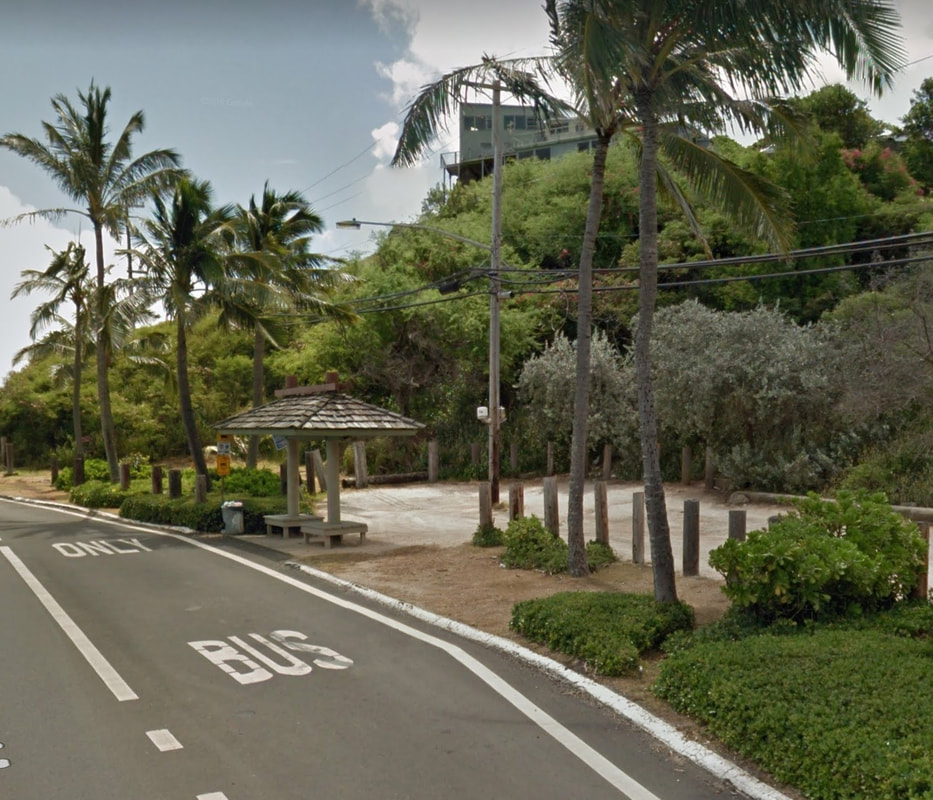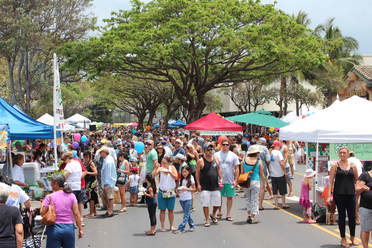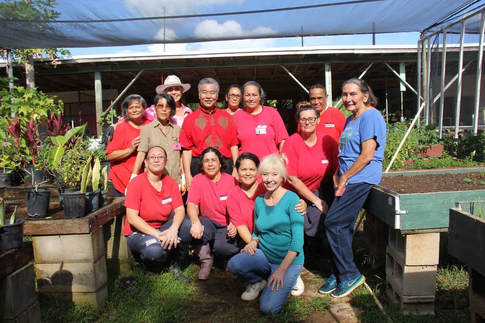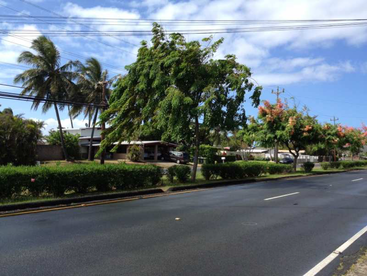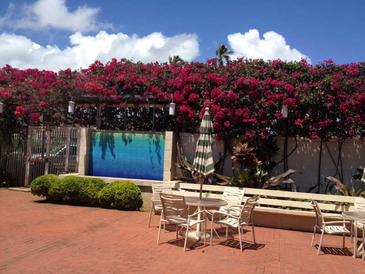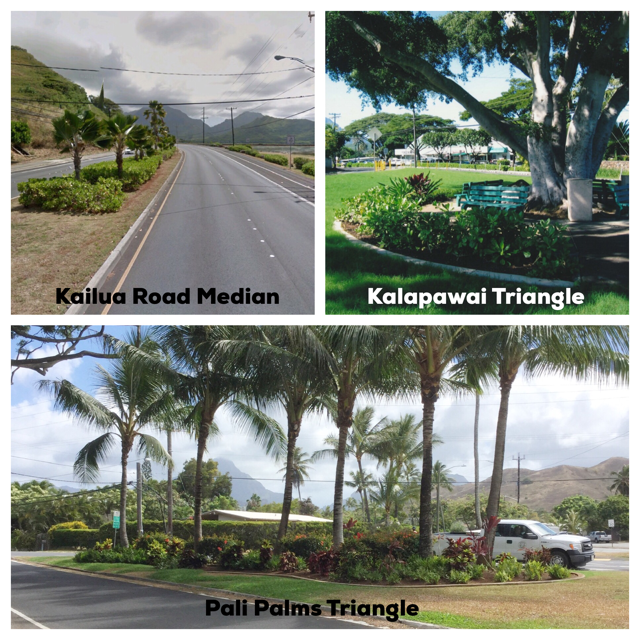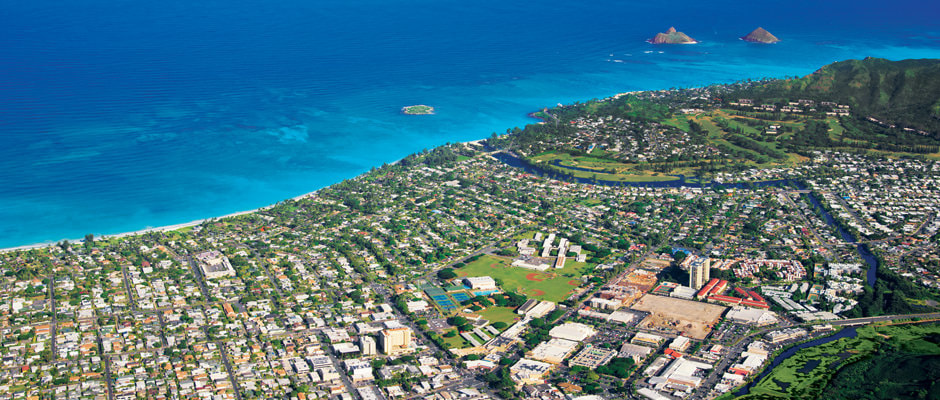History of the Lani-Kailua Outdoor Circle
On this page, you will find a written and pictorial history of LKOC
See also:
~ Interactive Map of LKOC Stewardship in Kailua since 1948
~ Slideshow Video of LKOC Tree Planting Projects in Kailua since 1948
~ List of LKOC Beautification Projects in Kailua since 1948
~ “Kailua Way Back When…” Booklet of The History of LKOC since 1948
See also:
~ Interactive Map of LKOC Stewardship in Kailua since 1948
~ Slideshow Video of LKOC Tree Planting Projects in Kailua since 1948
~ List of LKOC Beautification Projects in Kailua since 1948
~ “Kailua Way Back When…” Booklet of The History of LKOC since 1948
In May 1948, long before the Pali Tunnels made daily commuting from downtown Honolulu to the Windward side feasible, a small group of women gathered in the sleepy beach town of Kailua (population 3619) to organize the Lani-Kailua Outdoor Circle. More soon joined them and the Circle grew to more than 200 members within a few years.
Photo at the top of this page shows LKOC members working on the Kailua Road median in front of the old Kailua Theater (at right), circa 1950.
Photo at the top of this page shows LKOC members working on the Kailua Road median in front of the old Kailua Theater (at right), circa 1950.
Above photo of Kailua, circa 1940, looking makai, with Central Triangle in center.
The Banyan in the Central Triangle was planted by Lucius Tuckerman in 1926.
The Banyan in the Central Triangle was planted by Lucius Tuckerman in 1926.
1950-1960
By 1950 Kailua had 7,740 residents, with new subdivisions sprouting in Keolu Hills, Kalaheo Hillside, and Enchanted Lake. In 1949, the newly-formed Lani-Kailua Outdoor Circle began planting trees in the Kailua Road median as shown in the photo below. Tecoma trees were planted at the time, but in 1959, a major upgrade to the roadway occurred, and replacement trees, including Kamani, were planted. At that time, LKOC planted dozens of trees on Oneawa, Kainehe, Uluniu, Maluniu, Kihapai, and Hoolai Streets, with crews of LKOC volunteers out digging the holes, planting, and staking the trees. Many of these street trees are still there today, as exemplified by the beautiful elaeodendrons on Maluniu Street.
By 1950 Kailua had 7,740 residents, with new subdivisions sprouting in Keolu Hills, Kalaheo Hillside, and Enchanted Lake. In 1949, the newly-formed Lani-Kailua Outdoor Circle began planting trees in the Kailua Road median as shown in the photo below. Tecoma trees were planted at the time, but in 1959, a major upgrade to the roadway occurred, and replacement trees, including Kamani, were planted. At that time, LKOC planted dozens of trees on Oneawa, Kainehe, Uluniu, Maluniu, Kihapai, and Hoolai Streets, with crews of LKOC volunteers out digging the holes, planting, and staking the trees. Many of these street trees are still there today, as exemplified by the beautiful elaeodendrons on Maluniu Street.
Soon the group was instrumental in the landscaping and planting of over 2000 trees at the new schools being built, and along the streets of the new subdivisions and neighborhoods, including Kalama Tract, Bishop Tract (Kailua Estates), Coconut Grove, and Keolu Hills. Below are articles from the Windward Reporter lauding LKOC’s efforts to plant 200 Royal Poinciana trees in the Kailua Heights subdivision, part of the newly developed Enchanted Lake and Keolu Hillside area.
Above article from the Windward Reporter, Nov 21, 1957
Above article from the Windward Reporter, December 8, 1957
In 1951, LKOC began its now 70-plus-year efforts to preserve Kawainui Marsh and its archeological sites. At that time LKOC petitioned for, and was granted, a permit from the Territory of Hawaii’s Board of Agriculture and Forestry, to clear Ulupo Heiau, a site that remained largely unmarked on maps of the time. This directly led to its inclusion in the Territorial Parks System, in 1954, as shown in the following news articles at the time. It was listed on the National Register of Historic Places in 1972.
In the late 1950s, LKOC collaborated to have the central median of Kainui Drive planted with coconut trees. Today, the Drive has a stunning display of coconuts along its entire length as shown in photo below.
1960-1970
With the tunnels nearing completion, by 1960 Kailua's population had more than tripled to 24,402. Kaneohe Marine Base added another 6,397 to that figure. Our projects included assistance with planting at the newly built Castle Hospital and funds and labor to refurbish the Triangle Parks at Kailua Road and Oneawa Street, Kalapawai, and Lanikai.
We fought open burning at the Kailua dump on Quarry Road. We worked for bike paths to connect Kailua neighborhoods, pushed again for planting of more street trees, and then kept them watered and trimmed.
Kawainui Marsh preservation became an issue and we worked toward this goal. In the early 1960s, Kawainui was privately owned, and LKOC successfully led the effort to convince the Honolulu City Council to purchase 749 acres of the marsh slated for development of a 4000-home residential complex (as described in the following article written later in 1973, highlighting our commitment to the stewardship of Kawainui.) After this purchase, LKOC hired an architect/planner to develop plans for recreational and educational use, with an emphasis on cultural aspects of the marsh. This was in response to the City’s proposal for more active recreational use, including a small boat harbor, restaurant, and highway across the marsh, with no recognition of the cultural and archeological sites that would be destroyed. (See our Kawainui Marsh page for a photo of the City’s plan, as well as a documented history of our activities to preserve Kawainui Marsh).
With the tunnels nearing completion, by 1960 Kailua's population had more than tripled to 24,402. Kaneohe Marine Base added another 6,397 to that figure. Our projects included assistance with planting at the newly built Castle Hospital and funds and labor to refurbish the Triangle Parks at Kailua Road and Oneawa Street, Kalapawai, and Lanikai.
We fought open burning at the Kailua dump on Quarry Road. We worked for bike paths to connect Kailua neighborhoods, pushed again for planting of more street trees, and then kept them watered and trimmed.
Kawainui Marsh preservation became an issue and we worked toward this goal. In the early 1960s, Kawainui was privately owned, and LKOC successfully led the effort to convince the Honolulu City Council to purchase 749 acres of the marsh slated for development of a 4000-home residential complex (as described in the following article written later in 1973, highlighting our commitment to the stewardship of Kawainui.) After this purchase, LKOC hired an architect/planner to develop plans for recreational and educational use, with an emphasis on cultural aspects of the marsh. This was in response to the City’s proposal for more active recreational use, including a small boat harbor, restaurant, and highway across the marsh, with no recognition of the cultural and archeological sites that would be destroyed. (See our Kawainui Marsh page for a photo of the City’s plan, as well as a documented history of our activities to preserve Kawainui Marsh).
1970-1980
Our population of mostly young families was 33,783 in 1970, plus 7,860 more on the Marine Base. LKOC continued working to expand Kailua Beach Park, save Mount Olomana from development on it slopes, landscape the new Kailua post office, remove the Kapaa quarry roadside junkyard, and create height limitations for downtown Kailua.
In 1971, LKOC was successful in lobbying our City, State, and Federal legislators and officials to get trees planted in the median of Mokapu Boulevard, from Kalaheo Avenue to Oneawa Street, an area designated as a federally funded highway, in which median strip tree planting was disallowed. This effort involved LKOC sending numerous letters illiciting support from US Senators Hiram Fong and Daniel Inouye, US Representatives Patsy Mink and Spark Matsunaga, Hawaii Governor John Burns, State Department of Transportation head Fujio Matsuda, Honolulu Mayor Frank Fasi, and US Secretary of Transportation John Volpe.
This effort resulted in an exception being allowed for Mokapu Boulevard, and today the magnificent trees in that central median, including the extension from Kalaheo Avenue to Kaimalino, are a beautiful testament to the perseverance of our LKOC leaders at the time.
In the early 1970s, LKOC formed the Ad Hoc Committee for Kawainui. We were successful in stopping the development of an 88-acre shopping center in the Kahanaiki area of the marsh. We fought the Department of Public Works plan to implement a park concept using the marsh to accommodate 25 years of sanitary landfill (garbage). In 1976, LKOC petitioned the City to rezone approximately 250 acres of privately-owned land along the southern edge of the marsh, from Urban to Conservation, eventually resulting in 70 acres being rezoned in 1979.
1980-1990
In 1980 we had 35,812 residents (plus 11,578 Marines) and we successfully prevented the acquisition of Aikahi Triangle by developers, who wanted to expand the shopping center, and rerouted Mokapu Boulevard to its present position, creating the large tree-shaded park area you see at that corner today. Below is an article that appeared in the Sun Press Newspaper at the time, describing our efforts.
Above: Article in the Windward Sun Press Newspaper about our efforts at the Aikahi Park Triangle 5/14/1980
Also in the 1980s we pushed for trees in the medial strip along the entirety of Mokapu Boulevard (shown in the photo above and were were successful in facilitating the city's acquisition of the Boettcher Estate/Kalama Beach Park. From 1985-1990, LKOC professionally maintained many of the trees on the property.
In the early 1980s, LKOC convinced the City to relocate a sewer line from inside the Kawainui Marsh boundary to along Kalanianaole Highway and Kailua Road. LKOC spearheaded the formation of the Kawainui Heritage Foundation in 1983 and the effort to declare Kawainui eligible for inclusion on the National Register of Historic Places. In the late 1980s, LKOC petitioned the city to void previously granted permits to build a light industrial complex on the Wai'auia (ITT) site, resulting in the state ultimately purchasing the property and the removal of the partially constructed buildings there. In 2005, LKOC was a signed petitioner on the Ramsar Convention declaration of Kawainui as a "Wetland of International Importance".
1990-2000
By 1990, Kailua's population had stabilized at 36,818 residents and 11,662 Marines. Our projects included a major landscape project at Alala Point at the entrance to Lanikai, and landscaping of the corridor leading into Kailua town, refurbishment of the Pohakupu fountain and park landscaping, planting of the monkey pod trees at Kailua District Park, protection of Kaiwi Coastline from development, preservation and replanting of trees at Kailua Library, and expansion of Kailua Beach Park to its present area near the boat ramp. The Kailua Christmas "white lights" decorations were begun by LKOC in this period.
Windward Sun Press article below describes multiple landscaping and beautification project efforts of LKOC during the early 1990s, including the planting of trees around the newly re-built Pohakupu fountain.
By 1990, Kailua's population had stabilized at 36,818 residents and 11,662 Marines. Our projects included a major landscape project at Alala Point at the entrance to Lanikai, and landscaping of the corridor leading into Kailua town, refurbishment of the Pohakupu fountain and park landscaping, planting of the monkey pod trees at Kailua District Park, protection of Kaiwi Coastline from development, preservation and replanting of trees at Kailua Library, and expansion of Kailua Beach Park to its present area near the boat ramp. The Kailua Christmas "white lights" decorations were begun by LKOC in this period.
Windward Sun Press article below describes multiple landscaping and beautification project efforts of LKOC during the early 1990s, including the planting of trees around the newly re-built Pohakupu fountain.
Photos below show the original Pohakupu fountain that was demolished in 1992, and the replacement fountain as it exists today.
|
Alala Point Beautification Project
LKOC designed and installed a major landscape project at Alala Point, at the entrance to Lanikai, from boat ramp to the monument, on both the mauka and makai sides of Mokulua Drive. The project was started in 1992 (see article at left in the Windward Sun Press), and completed 1994. Since 1999, as part of our LKOC/WCCC Partnership, the WCCC Community Service Work-line women have been performing regular landscape maintenance of this entire area, under LKOC auspices. Above photo shows the upper parking lot landscaping today. |
In 1993, LKOC held the first "I Love Kailua" Town Party which has grown into a full-scale annual community event. This has been our major fundraiser, where proceeds are used for landscaping projects throughout Kailua town, as well as our educational outreach projects on the Windward side. Please visit our "I Love Kailua" Town Party page for more details on this event.
In 1993, as part of our educational outreach goals, LKOC began its scholarship program with Windward Community College. Since then, we have given yearly scholarships totaling over $68,000 to more than 80 students enrolled in Agricultural and Environmental Sciences Programs there. Please visit our WCC Scholarships page for more details on this important program that helps the next stewards of our land and natural resources.
In the mid 1990s, LKOC was instrumental in getting several trees on public property in Kailua ‘exceptionalized”. An Exceptional Tree is one recognized by the State of Hawaii as special and deserving of care and protection. These trees contribute greatly to our urban canopy, providing shade, cooling, health benefits, and beauty. The State Exceptional Tree Act (enacted in 1975) was spearheaded by the Outdoor Circle. Four trees in the Central Triangle of Kailua were exceptionalized by LKOC in the 1990’s. These include three Chinese Banyans and a Morton Bay Fig that provide a stunning focal point as you enter the Kailua business district. Please visit our Tree Preservation page for more details on our efforts at preserving Kailua’s tree canopy over the years.
In 1998, we collaborated with the Coconut Grove Tomorrow Forum and the newly formed Coconut Grove Association to plant 40 coconut trees in the area. It was estimated at the time that of the original 30,000 trees that once existed in the area, only 3,000 were left.
In 1999, LKOC formed the LKOC/WCCC Partnership to provide horticultural training programs at the Women's Community Correctional Center (WCCC), where the women in our "Learning to Grow" program learn skills which will help them find jobs upon release. In addition, since 1999, LKOC has been providing equipment for WCCC's Community Service Workline, who maintain the landscaping at some of Kailua's parks and roadsides (including the Kailua Road entrance to Kailua), thus saving many taxpayer dollars. Please visit our LKOC/WCCC Partnership page and our Volunteer Opportunities page for more details on this life-altering program, and how you can get involved as a volunteer. It is a truly rewarding experience.
The Honorable Governor David Ige visits the "Learning to Grow" nursery in September 2017
2000 - 2010
In 2000, Kailua’s population remained stable at 36,513 residents and with 12,000 military personal at MCBH. LKOC continued is planting and landscape maintenance projects within the community.
In 2002, three spectacular Monkey pod specimens on the grounds of Women’s Community Correctional Center were “exceptionalized” by LKOC. These majestic trees, which are clearly visible from Kalaniana’ole Highway, attract visitors and residents alike. In exchange for WCCC's agreement to allow them deemed 'exceptional', LKOC committed to pay for their pruning and maintenance, as our contribution to our community. Since 2004, LKOC has spent well over $33,000 to date, on their professional trimming every few years.
In the early 2000s, we installed new plants at Kailua Post Office and Hawaiian Tel building on Kuulei Road, and planted silver trumpet trees in the municipal parking lot between Maluniu and Aulike Streets. We replaced the dead Wiliwili trees with shower trees on Mokapu Boulevard in 2007. In 2010, we partnered with the Friends of Kailua Library to refurbish the courtyard.
2010-Present
In 2010, Kailua's population was 38,635, with 9517 military personnel. In addition to our tree planting and beautification efforts in Kailua, we continued to advocate for adherence to our State's exemplary sign laws regarding outdoor and aerial commercial advertising, as well as actively advocated for responsible development, limiting commercial activity at our beach parks, and the preservation of the Kawainui/Hamakua Marsh. Please visit our Signs, Public Affairs and Advocacy, and Kawainui Marsh pages for more information about our important efforts here.
We are proud of our latest landscaping projects at the Kalapawai and Pali Palms Triangles at either end of Kalaheo Avenue, at which we designed, installed and have been maintaining the landscaping for the city since 2010 and 2011 respectively (see photos above).
Recently, in 2017, we adopted Kalama Beach Park through the city's 'Hoa Paka' program, and do regular volunteer workday maintenance there, involving removal of invasive species, and major landscape trimming, pruning, and cleanup.
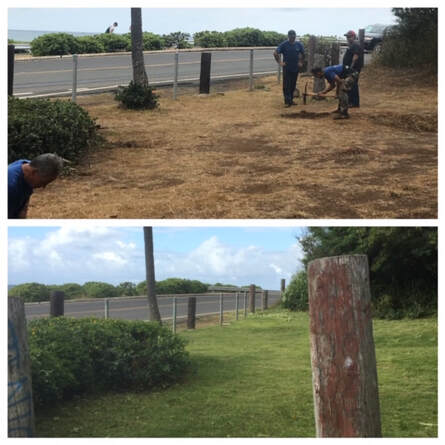 Before and After Photos or 2019 Alala Point Landscape Refurbishment
Before and After Photos or 2019 Alala Point Landscape Refurbishment
In 2019, LKOC performed a landscape refurbishment of Alala Point, at the entrance to Lanikai. We installed new wax ficus hedges and lawn, as well as upgraded the bollards around the parking lot. As noted above, the original landscaping was installed there by LKOC in 1994, and has been maintained by the “Community Service Workline” from WCCC, under LKOC auspices, since 1999. Photo at left shows a before and after of this recent re-landscaping.
In 2020, LKOC began working with the City on a new street tree planting project along Oneawa Street, from Kawainui Street to Kuulei Road, a three block long area in downtown Kailua’s central business district. The project has now been completed wherein 8 new trees were planted to replace 13 that had failed and been removed over the past 20 years. This will return this section of Oneawa to an attractive arbor of trees on both sides of the street, providing much needed shade, and an inviting atmosphere for residents and visitors alike.
LKOC continues to be actively involved in the maintenance and enhancement of our urban tree canopy through the protection of older trees and the planting of new trees in our public spaces. By working with other like-minded organizations, as well as Federal, State, and County entities, we have made a difference!
Please visit our LKOC Beautification Projects and Tree Preservation pages for more details on our activities in this effort, including a short video as well as a map of site locations.
How You Can Help
While ours is a volunteer organization, much of what we do requires major funding. To raise money for these projects, we sponsor the "I Love Kailua" Town Party, which is open to the general public. This event raises funds through our LKOC plant sales, LKOC Town Party t-shirt and button sales, and food vendor sales, as well as raises awareness of beautification and environmental issues in our community. These activities and your contributions in support of our organization are what make it possible to continue our work toward the goal of "Keeping Kailua Clean, Green, and Beautiful."
To join us, or support us, please visit our Join The Circle page!
Please visit our Mahalo page, where we express our thanks and appreciation for all of our generous supporters and sponsors, our dedicated volunteers, and all those who support our mission here in Kailua and on the Windward side! We couldn’t do it without you!
LKOC ~ Dedicated to "Keeping Kailua Clean, Green, and Beautiful!" since 1948!
